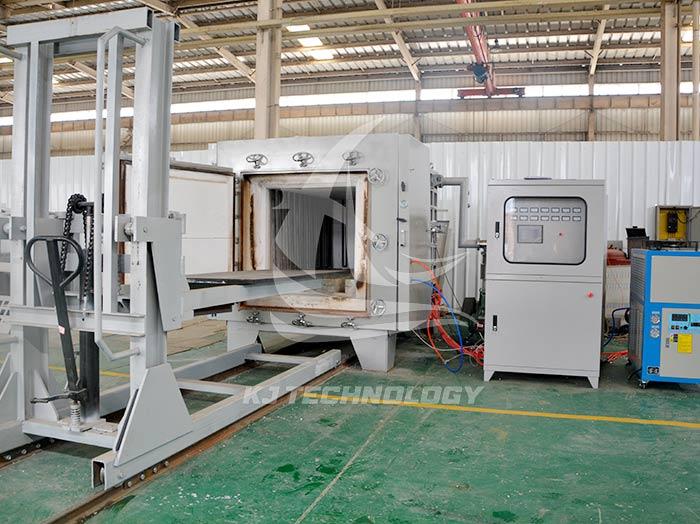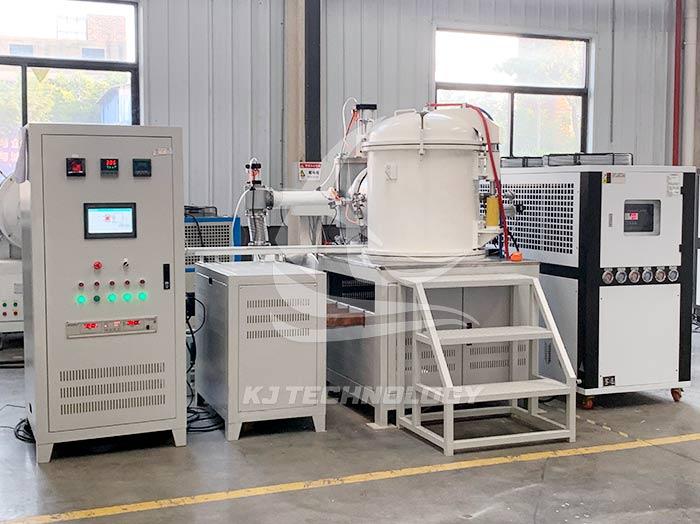Working principle of vacuum muffle furnace
 08-04-2025 Author: KJ technology
08-04-2025 Author: KJ technology
The vacuum muffle furnace provides heat treatment conditions for materials under anaerobic or specific atmospheres by combining vacuum environment and high-temperature heating technology. Its working principle can be divided into four core modules: vacuum system operation, heating system operation, atmosphere control system regulation, and temperature control system control. The following is a detailed explanation:
1. Vacuum system operation: creating an anaerobic environment
Vacuum pump start
Before the experiment begins, close the furnace door and start the vacuum pump (such as a rotary vane pump or molecular pump).
The vacuum pump extracts the air from the furnace through the pipeline, gradually reducing the air pressure to the target vacuum degree (such as 10 ⁻³ Pa to 10 ⁻⁷ Pa).
Function: Isolate oxygen and prevent material oxidation at high temperatures (such as metal melting and ceramic sintering).
Sealing and leakage detection
The furnace door is sealed with silicone sealing rings or metal flanges, and locked by rotating the four corner handwheel to ensure airtightness.
Some equipment is equipped with vacuum gauges to monitor real-time pressure changes inside the furnace. If the pressure rises abnormally (such as leakage), the system will automatically alarm and stop heating.
2. Heating system operation: achieving high-temperature treatment
Heating element selection
Resistance wire: suitable for low temperature (≤ 1200 ℃) scenarios, with low cost but short lifespan.
Silicon carbon rod: resistant to high temperatures (≤ 1600 ℃), suitable for ceramic sintering and metal annealing.
Graphite heater: capable of reaching a maximum temperature of 3000 ℃, used for high-temperature melting or synthesis of special materials.
Heating method: Heating elements are evenly distributed around or at the bottom of the furnace, and heat is transferred through thermal radiation.
Temperature uniformity control
The inner wall of the furnace is made of high thermal conductivity materials (such as alumina fiberboard) to reduce heat loss.
Multi zone independent temperature control technology: The furnace is divided into multiple heating zones, each equipped with independent thermocouples and PID controllers to ensure temperature uniformity (temperature difference ≤ ± 5 ℃).
3. Atmosphere control system regulation: meeting diverse process requirements
Atmosphere type selection
Inert atmosphere: Fill with nitrogen (N ₂), argon (Ar), etc. to protect the material from oxidation (such as sintering of metal based composite materials).
Reductive atmosphere: filled with hydrogen gas (H ₂) or a mixture of hydrogen and nitrogen gas, used for metal surface infiltration treatment (such as carburizing, nitriding).
Reactive atmosphere: filled with carbon source gas (such as methane) or nitrogen source gas (such as ammonia) for material synthesis (such as silicon carbide ceramic preparation).
Atmosphere control process
After the vacuum pump stops, the target gas is filled into the furnace through a gas flow meter to atmospheric pressure or a specific pressure.
Some devices support dynamic atmosphere control: gas is continuously introduced during the heating process to maintain a constant concentration (such as in chemical vapor deposition processes).
4. Temperature control system control: achieving precise process control
Temperature sensor and controller
Thermocouple: K-type or S-type thermocouples are used to measure the actual temperature inside the furnace, with an accuracy of ± 1 ℃.
PID controller: automatically adjusts the heating power based on the deviation between the set temperature and the actual temperature, achieving rapid heating, constant temperature insulation, and programmed cooling.
Program heating function
Support multi segment program heating (such as 30 segment programmable control), each segment can set target temperature, heating rate, and insulation time.
Example:
Stage 1: Heat up to 500 ℃ at a rate of 10 ℃/min and hold for 30 minutes (to remove adsorbed gases on the material surface).
Stage 2: Heat up to 1200 ℃ at a rate of 5 ℃/min and hold for 2 hours (ceramic sintering).
Stage 3: Cool down with the furnace to room temperature (to avoid rapid cooling causing cracking).
Security protection mechanism
Over temperature protection: When the temperature exceeds the set value ± 10 ℃, the heating power supply will be automatically cut off.
Leakage protection: Detect the leakage current of the equipment and immediately cut off the power when it exceeds the safety threshold.
Gas leakage detection: For flammable gases such as hydrogen, a hydrogen sensor is equipped, which automatically exhausts and alarms in case of leakage.
5. Workflow example: Ceramic material sintering
Loading: Place the ceramic powder compacts into the alumina crucible inside the furnace.
Vacuum pumping: Start the vacuum pump to reduce the pressure inside the furnace to 10 ⁻ Pa.
Fill with nitrogen: Stop the vacuum pump, fill with high-purity nitrogen to atmospheric pressure, repeat vacuum pumping and inflation 3 times to completely eliminate oxygen.
Heating sintering:
Heat up to 800 ℃ at a rate of 5 ℃/min and hold for 1 hour (excluding organic binders).
Heat up to 1600 ℃ at a rate of 3 ℃/min and hold for 4 hours (ceramic densification).
Cooling: Cool down with the furnace to room temperature and remove the sintered body.
Restore normal pressure: Open the vent valve to balance the pressure inside the furnace with the outside, and open the furnace door.








